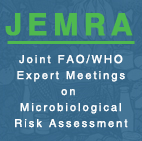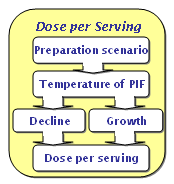 |
Risk Assessment for Cronobacter sakazakii in Powdered Infant Formula |

 |
|
|
|
|
|
|
|
Preparation and Handling Scenarios
The model is designed to enable the exploration of specific preparation and handling scenarios. Each scenario is defined in terms of four processes:
-
Preparation of the formula including rehydration of the powder
-
Storage or holding of the product following preparation
-
Re-warming prior to feeding if necessary
-
Feeding of the formula.
For each of these processes the duration (in hours), the ambient temperature (in °C) and the holding conditions are required. In addition, the temperature or range of temperatures to be explored for the rehydrating liquid is also specified (in °C).
|
Using the above information for the scenarios, the temperature of the prepared formula during the time from preparation to the completion of feeding is estimated providing a time-temperature profile of the prepared formula. This profile is then used to estimate the extent of growth or temperature-related inactivation that may occur in any contaminating C. sakazakii populations. The cumulative effect of the growth and decline of the population over the time from preparation to the end of the feeding period provides an estimate of the level of C. sakazakii ingested.
Rather than attempting to represent the variety of preparation measures currently in use by consumers, the model should be used to explore a variety of possible preparation scenarios which can be compared in terms of the risks posed to the infant population. These comparisons will facilitate risk managers in the identification of the most risk-averse scenarios with respect to C. sakazakii providing a basis for the development of guidance and advice for consumers on the preparation, handling and storage of PIF. |
 |
|
|
|
|
|
|
|
|
|
|